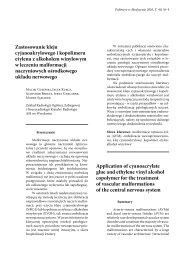Locust bean Gum as Superdisintegrant - Polimery w Medycynie
Locust bean Gum as Superdisintegrant - Polimery w Medycynie
Locust bean Gum as Superdisintegrant - Polimery w Medycynie
You also want an ePaper? Increase the reach of your titles
YUMPU automatically turns print PDFs into web optimized ePapers that Google loves.
20 KARAN MALIK et al.<br />
Table 1. Formulation code table of the formulated tablet batches<br />
Tabela 1. Kod składu przygotowanych partii tabletek<br />
Ingredients<br />
(mg)<br />
A1 A2 A3 A4 B1 B2 B3 B4<br />
Nimesulide 100 100 100 100 100 100 100 100<br />
<strong>Locust</strong> <strong>bean</strong> gum 6.25 12.5 18.75 25 – – – –<br />
Crosscarmellose sodium – – – – 6.25 12.5 18.75 25<br />
Avicel PH 101 138.75 132.5 126.25 120 138.75 132.5 126.25 120<br />
Talc 2.5 2.5 2.5 2.5 2.5 2.5 2.5 2.5<br />
Magnesium stearate 2.5 2.5 2.5 2.5 2.5 2.5 2.5 2.5<br />
Hardness<br />
The hardness of the tablets w<strong>as</strong> determined by<br />
using a Hardness testing apparatus (Monsanto hardness<br />
tester). A tablet hardness of about 4‐5 kg/cm 2 is<br />
considered adequate for mechanical stability. Determinations<br />
were made in triplicate.<br />
Friability<br />
Twenty tablets were weighed and placed in<br />
a Roche friabilator and rotated at 25 rpm for 4 min.<br />
The tablets were taken out, dedusted and reweighed.<br />
The weight loss should not be more than 1 %. The<br />
percentage friability of the tablets w<strong>as</strong> calculated by<br />
the formula:<br />
=<br />
Percentage friability = Repeated twice<br />
Initial weight – Final weight * 100<br />
Initial weight<br />
Me<strong>as</strong>urement of tablet tensile strength<br />
The tablet tensile strength is the force required<br />
to break a tablet by compressing it in the radial direction<br />
and is me<strong>as</strong>ured using a monsanto hardness tester.<br />
For me<strong>as</strong>uring the hardness of the tablets, the<br />
plunger of the hardness tester is driven down at<br />
a speed of 20 mm/min. Tensile strength for crushing<br />
(T) is calculated using equation:<br />
T = 2F / πdt<br />
Where: F is the crushing load, and d and t signify<br />
the diameter and thickness of the tablet, respectively.<br />
Wetting Time<br />
A piece of tissue paper (10.75×12 mm) folded<br />
twice w<strong>as</strong> placed in a culture dish (d=6.5 cm) containing<br />
6 ml of water (containing a water soluble dye<br />
eosin). A tablet w<strong>as</strong> carefully placed on the surface of<br />
tissue paper and the time required for water to reach<br />
the upper surface of the tablet w<strong>as</strong> noted <strong>as</strong> the wetting<br />
time [21].<br />
Water Absorption Ratio<br />
Test w<strong>as</strong> done with the same procedure <strong>as</strong> that of<br />
wetting time. In this test initial weight of tablet w<strong>as</strong><br />
taken before placing on petri dish. After complete<br />
wetting the wetted tablet w<strong>as</strong> then weighed. Water<br />
absorption ratio, R w<strong>as</strong> determined using the equation:<br />
R = 100 (W b –W a )/W b<br />
Where: W a is weight of tablet before water absorption<br />
and W b is weight of tablet after absorption [21].<br />
Effective pore radius (R eff.P )<br />
Reff.P of the powder blend w<strong>as</strong> determined using<br />
method reported by Rana et al [22]. In this method<br />
a micropipette tip (2ml, transparent) w<strong>as</strong> completely<br />
filled with powder and weighed (W i ). Then<br />
n-hexane (surface tension (γ) 18.4 mN/m) w<strong>as</strong> poured<br />
dropwise on bedtop till the solvent filtered out at the<br />
bottom of the tip. The tip w<strong>as</strong> reweighed (W f ). The<br />
experiments were repeated 3 times:<br />
R eff.P = W f –W i / 2πγ
















